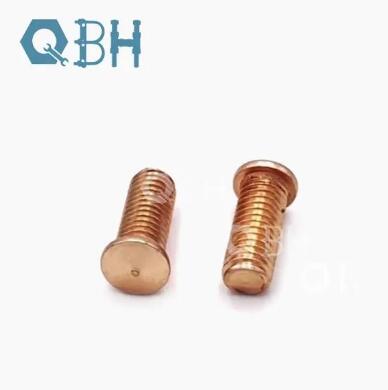The Manufacturing and Installation Process of DIN32501 Brass Welding Studs
2024-09-04
DIN32501 Brass Welding Studs are integral components in various industrial applications, known for their strength, conductivity, and corrosion resistance. However, the effectiveness of these studs depends not only on their design and material properties but also on their manufacturing and installation processes. In this blog, we will delve into how these welding studs are manufactured and installed, ensuring optimal performance in their intended applications.
Manufacturing Process of DIN32501 Brass Welding Studs
1. Material Selection and Alloying
The first step in manufacturing DIN32501 Brass Welding Studs involves selecting the appropriate brass alloy. Brass is typically composed of copper and zinc, with the exact proportions varying depending on the desired properties. For welding studs, a specific brass composition is chosen to balance electrical conductivity, strength, and corrosion resistance.
2. Forming the Stud
Once the brass alloy is prepared, the material is formed into the stud's shape. This process typically involves extrusion or forging, where the brass is heated and then shaped under high pressure. The stud may feature a threaded end for applications requiring a secure mechanical connection.
3. Machining and Threading
After forming, the studs undergo machining to achieve precise dimensions and specifications as per the DIN32501 standard. If the stud is to have a threaded end, threading is done using a CNC (Computer Numerical Control) machine to ensure accuracy and consistency.
4. Surface Treatment
To enhance the corrosion resistance and durability of the stud, a surface treatment is often applied. This may include polishing, coating, or plating with additional materials like nickel or tin, depending on the specific application requirements.
5. Quality Control
Quality control is a critical step in the manufacturing process. Each batch of DIN32501 Brass Welding Studs undergoes rigorous testing to ensure they meet the required standards for strength, conductivity, and dimensional accuracy. This testing may include tensile strength tests, conductivity measurements, and visual inspections for surface defects.
Installation Process of DIN32501 Brass Welding Studs
1. Preparation of the Surface
Before welding the stud, the surface where it will be attached must be properly prepared. This involves cleaning the surface to remove any dirt, grease, or oxidation that could interfere with the welding process. In some cases, the surface may also be roughened to improve the bond between the stud and the base material.
2. Positioning the Stud
Once the surface is prepared, the stud is positioned at the desired location. Precision is crucial at this stage to ensure that the stud is correctly aligned and will provide the necessary electrical or mechanical connection.
3. Welding the Stud
The stud is then welded to the base material using a suitable welding technique. Common methods include resistance welding, arc welding, or capacitor discharge welding. The choice of welding method depends on factors such as the thickness of the base material, the size of the stud, and the specific application requirements.
4. Cooling and Inspection
After welding, the stud and the surrounding area are allowed to cool. This cooling process must be controlled to prevent any warping or distortion of the stud or base material. Once cooled, the weld is inspected to ensure it meets the required strength and conductivity standards.
5. Post-Weld Treatment
In some cases, post-weld treatments such as stress relief or additional surface coatings may be applied to enhance the durability and performance of the welded stud. These treatments are particularly important in applications exposed to harsh environmental conditions.
Common Challenges in the Installation Process
1. Material Compatibility
Ensuring compatibility between the brass stud and the base material is crucial for a successful weld. Differences in thermal expansion rates and electrical conductivity can affect the quality of the weld.
2. Welding Technique Selection
Choosing the correct welding technique is essential to avoid issues such as weak bonds or excessive heat that could damage the stud or base material. Operators must be trained to select and execute the appropriate welding method.
3. Alignment and Positioning
Incorrect positioning or misalignment during the welding process can result in a suboptimal connection, compromising the stud's performance. Careful planning and precision tools are needed to avoid such issues.
Applications Requiring Specialized Installation Techniques
1. High-Voltage Electrical Systems
In high-voltage systems, the welding process must ensure that the stud provides a reliable and safe electrical connection. This may involve additional insulation or protective measures during installation.
2. Marine and Offshore Installations
For marine applications, additional corrosion-resistant treatments may be applied post-welding to protect the stud from saltwater exposure.
3. Automotive Industry
In automotive applications, welding must account for the potential for vibration and thermal cycling. Specialized techniques may be used to ensure that the stud remains secure under these conditions.
Conclusion
The manufacturing and installation of DIN32501 Brass Welding Studs are complex processes that require careful attention to detail. From selecting the right materials to ensuring precise installation, each step is critical to the stud's performance in its final application. By understanding these processes, manufacturers and engineers can ensure that their assemblies are both reliable and efficient, making the most of the unique properties of DIN32501 Brass Welding Studs.



